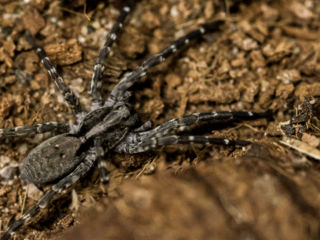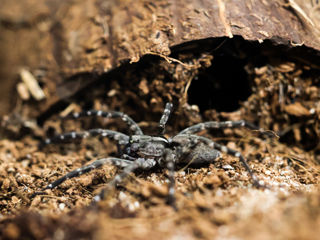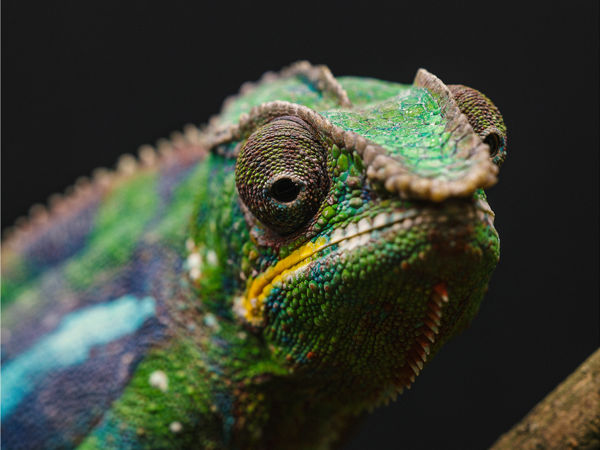
Desertas Wolf Spider
Key Facts
Scientific name: Hogna ingens
Range: Vale da Castanheira (north of Deserta Grande Island)
Habitat: Below rocks and in soil crevices
Diet: Invertebrates (beetles, millipedes) and sometimes juvenile lizards
Average size: Up to 12cm leg span
Lifespan: Unknown
IUCN Red List: Critically Endangered
Desertas wolf spiders are Critically Endangered and endemic to Deserta Grande Island in the Portuguese Desertas archipelago (cluster of islands) – this means these wolf spiders only exist in the wild within this small location. Desertas wolf spiders are a visually distinctive species with grey bodies, black and white banded legs and a red dot that sits either side of their jaw.

Desertas wolf spiders are thought to live exclusively within a 2.8km-long valley (The Vale da Castanheira) in the north of Deserta Grande Island. Despite them living within such a small and secluded area, they still face threats in the wild, highlighting the importance of the conservation efforts like protected areas that are in place to protect species that live in such small ranges
In the absence of native terrestrial (land-dwelling) mammals, these agile arachnids are apex (top) predators within their habitats, and are thought to be very important in regulating the invertebrate populations of other species they consume within the area
Individuals of this species will only breed once or twice throughout their lives after waving their front legs to attract their mate

· It’s important to protect animals’ wild behaviour in zoos, as well as making sure their populations are stable. Zoos across the UK have been working hard to research the best conditions to encourage burrowing behaviour for Desertas wolf spiders in zoo-based settings and have found they prefer substrate (bedding material) that is light, loose and at least 5cm thick
· As one of the largest species of wolf spider in the world, females of this species are larger than the males and can reach a leg span of up to 12cm and a body length of up to 4cm. This difference in size between males and females is referred to as sexual dimorphism.
Desertas wolf spiders are Critically Endangered according to the IUCN Red List, meaning they are at very substantial risk of extinction. This is due to:
Invasive species: Within Desertas wolf spider range, non-native grass is colonizing the area and covering the soil and rocks. This makes the microhabitats (small habitats) below the rocks less easy to access for the Desertas wolf spider and if the spread continues, this may make breeding and maintaining healthy populations even more difficult for them.
-
![362277039 664600909026309 8369226469419348221 N]()
What we're doing...
EEP: Desertas wolf spiders are part of an EEP (EAZA Ex-situ Programme) for population management. The aims of this EEP are to maintain healthy populations of Desertas wolf spiders to increase the diversity (genetic variety) of their captive (zoo-based) populations, but also to support zoos in educating the general public about the threats they face in the wild
· Education: Our dedicated Conservation Education team are on hand to discuss the threats that Desertas wolf spiders face, and the challenges that invasive species can cause more broadly
-
![Desertas Wolf Spider (1)]()
How you can help?
By choosing to visit and support conservation charities like Twycross Zoo, your money is contributing to the care of critically endangered species like the Desertas wolf spider, along with many more animals facing significant threats in their wild habitats



